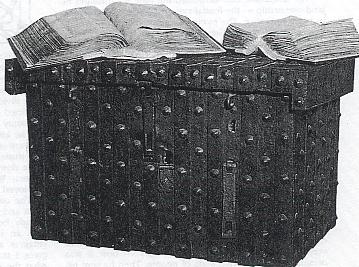|
In 1086, just twenty years after
William, Duke of Normandy, later known as William the Conqueror defeated King Harold at the Battle of Hastings, King William
is believed to have sent his troops from London to seize what land etc. they could. The holdings they seized were gradually
confirmed by the King who it seems wanted to know the value of his Kingdom and the distribution of lands held by his Normans.
The making of the Domesday Survey had been launched the previous year at William the Conqueror's Christmas Court.
Initially each tenant-in-chief, whether Bishop, Abbot, or Baron and each Sheriff and other local officials were required to
send in a list of Manors and men. All of England, apart from the northern counties, which were not yet firmly under
Norman control, was divided into seven circuits.
The Worcester circuit was travelled
by Remigius, Bishop of Lincoln and Lord of the Manor of Holdingham, with a Clerk and two Monks in attendance and three important
laymen. King William had this information written down in the Domesday Book.
There is no doubt that as our earliest
public record and number one in the Public Record Office's index, the Domesday Book is a remarkable survey. Once the Domesday
Book had been completed, it was kept in the Exchequer and used on a daily basis as a reference work. In its early years it
was carried around the country with the court and monarch. During the Middle Ages it was moved to Westminster, where it remained
until 1859 when it was taken to its present home, the Public Record Office in Chancery Lane.
The medieval clerical
Latin used in the Domesday Book is very stylised and often heavily abbreviated and would be impossible to read without special
training. English translations did not appear until the nineteenth century, when separate counties were translated by different
scholars and published either in County Record Office volumes, or by Victoria County Histories. The translations varied hugely
in reliability and because there had been no agreed system to deal with the abbreviations there was dispute over the interpretation
of some of the words, which led to confusion.
There are two (2) Sleaford manors mentioned in the Domesday Book.
Below
is the original entry in medieval clerical Latin of the larger of the two (2) Sleaford manors later known as the Manor of
Holdingham, after the name of the hamlet which bears the same name.
The scribe would have made the entry in the Domesday Book using a hard baked goose quill dipped into
black and red ink.
Below is a later translation from the Latin entry in the Domesday Book.
Manor. In Eslaforde Bardi had II carucates of land assessed to the geld. There is land for II
teams. The Bishop has 3 teams in demesne and 29 villeins and 6 sokemen and II borders having 14 teams. There
is a priest there and a church and 8 mills rendering 10 pounds, and 320 acres of meadow, and 1 acre of underwood, and 330
acres of marsh. TRE it was worth 20 pounds; now 25 pounds. In the 1960s, a new uniform translation was started
by Dr. John Morris of University College London, and he gathered together a group of medieval Latinists to produce a unified
format. The project was completed in 1985 and the 35 volumes have all been published by Phillimore, the specialist local
history publisher. Below is the new uniform translation of the manor of Holdingham.
M. In (New) SLEAFORD Barthi had II carucates of land taxable. Land for II ploughs. The Bishop
has in lordship 3 ploughs; 29 villagers, 6 Freemen and II smallholders who have 14 ploughs. A priest and a church; 8
mills at 10 Pounds; meadow, 320 acres; underwood, 1 acre; marsh, 330 acres. Value before 1066 20 Pounds; now 25 Pounds.
The other Sleaford manor was smaller and belonged to Ramsey Abbey in Cambridgeshire. It is generally
supposed that it was split from the original manor only perhaps 60 years or so before the Domesday Book was compiled and its
subsequent history is rather obscure. It looks as if it may be the unit later called "Old Sleaford", which passed (by
means nobody knows) to the Hussey family in the fifteenth century.

The original two volumes of the Domesday Book are kept in this chest which is stored in the Public Record
Office. Every few centuries they are very carefully removed so that they can be rebound.
____________________________
An English Postage Stamp commemorating The Domesday Book 1086.
|